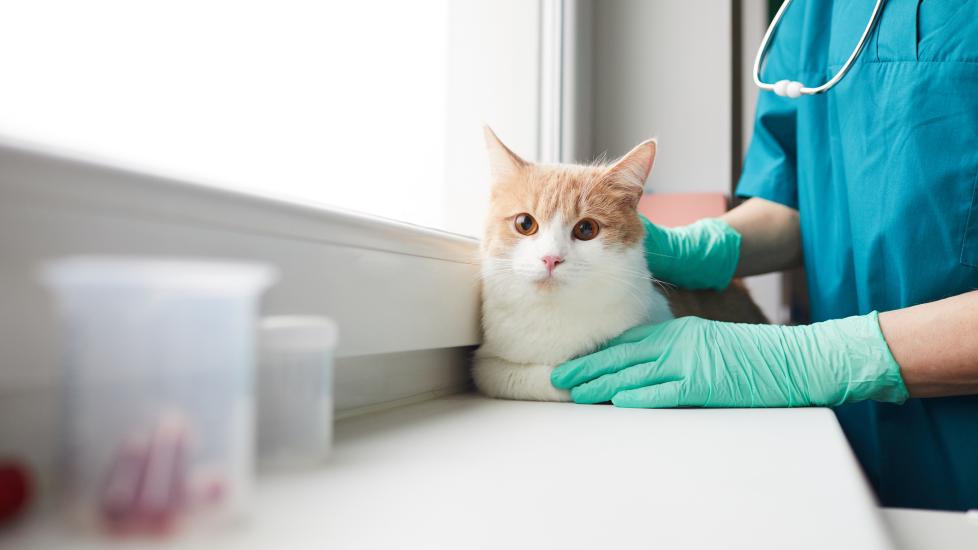Enlarged Spleen in Cats
AnnaStills/iStock / Getty Images Plus via Getty Images
What Is an Enlarged Spleen in Cats?
The medical term for an enlarged spleen in cats is feline splenomegaly. If your cat’s spleen is very large, their belly may have a bloated appearance. Otherwise, you commonly can’t tell from looking at your cat that they have an enlarged spleen in their abdomen.
This can happen due to masses or nodules in the spleen, inflammation of the spleen, or a backup of blood into the spleen (congestion). Some, but not all, causes of splenic enlargement may cause pain or discomfort. A significant increase in size can put pressure on surrounding organs.
While mild cases of splenic enlargement might occur relatively frequently, splenomegaly is not a very common medical problem in cats.
If your cat is pale, collapsing, repeatedly vomiting, or yowling when their abdomen is touched, seek emergency care. Splenic enlargement is one of many possible causes of these emergency symptoms.
Symptoms of an Enlarged Spleen in Cats
The symptoms of an enlarged spleen in cats aren’t specific to the condition. This means they could indicate a whole host of different things, and splenomegaly based on these symptoms alone is not enough for a diagnosis.
Symptoms of an enlarged spleen in cats include:
-
Bloated abdomen
-
Abdominal pain
-
Vomiting or diarrhea
Splenomegaly often occurs secondary to another condition, such as an infection. In these cases, your cat may have other symptoms that depend on the underlying cause.
For example, a cat with an infectious cause might also have a fever, and a cat with an autoimmune cause like immune-mediated hemolytic anemia (IMHA) might also have pale or jaundiced gums.
Causes of an Enlarged Spleen in Cats
Causes of enlarged spleen in cats can include:
-
Cancers such as mast cell tumors or leukemia (which occur secondary to feline leukemia virus)
-
Infections such as cytauxzoonosis, feline infectious peritonitis (FIP), histoplasmosis, or hemotropic mycoplasmosis
-
Congestion (blood backing up into the spleen) due to sedatives or right-sided congestive heart failure (CHF)
-
Nodular hypoplasia (sometimes occurs as a normal aging change)
-
Extramedullary hematopoiesis (bone marrow isn’t working well so the spleen makes red blood cells)
-
Splenic hematomas (solid swelling of clotted blood)
How Veterinarians Diagnose an Enlarged Spleen in Cats
A veterinarian might be able to feel an enlarged spleen in cats when they palpate (examine by touch) the abdomen.
X-rays of the abdomen can also show an enlarged spleen. Ultrasonography of the abdomen allows for more detailed examination and can identify things like splenic masses, changes to the spleen’s architecture, or fluid in the abdomen that might be related to splenomegaly.
Your veterinarian may recommend a procedure called a fine needle aspirate (FNA), which is the collection of a sample of cells acquired by putting a needle into the spleen and suctioning cells into the syringe. The cells are placed on a lab and examined under a microscope, often at a specialty lab. If your veterinarian recommends a splenic FNA, your cat will need to be sedated to prevent accidental laceration of the spleen, which could result in significant internal bleeding.
Treatment of an Enlarged Spleen in Cats
Treatment of enlarged spleen in cats varies depending on the cause of splenomegaly. Some cases do not require treatment, such as splenic enlargement that occurs after administering sedatives.
In some cases, such as a bleeding splenic hematoma, removal of the spleen (splenectomy) is an effective and curative treatment. If significant blood loss was associated with the splenic hematoma, the cat may also require a blood transfusion.
Some infectious causes may be treated with antifungals or antibiotics. Other infectious causes of an enlarged spleen have a very poor prognosis, although some have a better outlook with early and aggressive treatment.
With cancerous causes, treatment options include removal of the spleen (if the tumor is only in the spleen) and chemotherapy. Most malignancies affecting the spleen do not have a favorable long-term prognosis, but treatment can provide relief and prolong life.
If your cat’s splenomegaly is secondary to cancer, they may be referred to a veterinary oncologist for specialized care.
Recovery and Management of Enlarged Spleen in Cats
Recovery for an enlarged spleen in cats depends on why your cat’s spleen was enlarged. Some cases don’t affect their health and they can recover on their own.
If your cat has an infectious cause, they may be hospitalized for several days. A lot of the infectious causes of enlarged spleen require prolonged administration of medications. For example, treatment for histoplasmosis involves administering antifungal medications for several months. You will have more frequent check-ins with the veterinarian to monitor progress.
If your cat had surgery, you’ll want to keep them from licking their incision. Recovery cones, e-collars, or recovery suits may be a good option.
Follow your veterinarian’s instructions for post-operative activity restrictions.
Prevention of Enlarged Spleen in Cats
Some causes of enlarged spleen in cats aren’t preventable. However, you can reduce the risk of infectious diseases that cause splenic enlargement by vaccinating your cat against feline leukemia virus (FeLV) and staying up to date on flea, tick, and heartworm preventives.
Follow your veterinarian’s recommendations regarding frequency of wellness exams. Your veterinarian may be able to detect conditions before they develop symptoms. Early detection means earlier intervention, which can slow the progression of chronic diseases.
